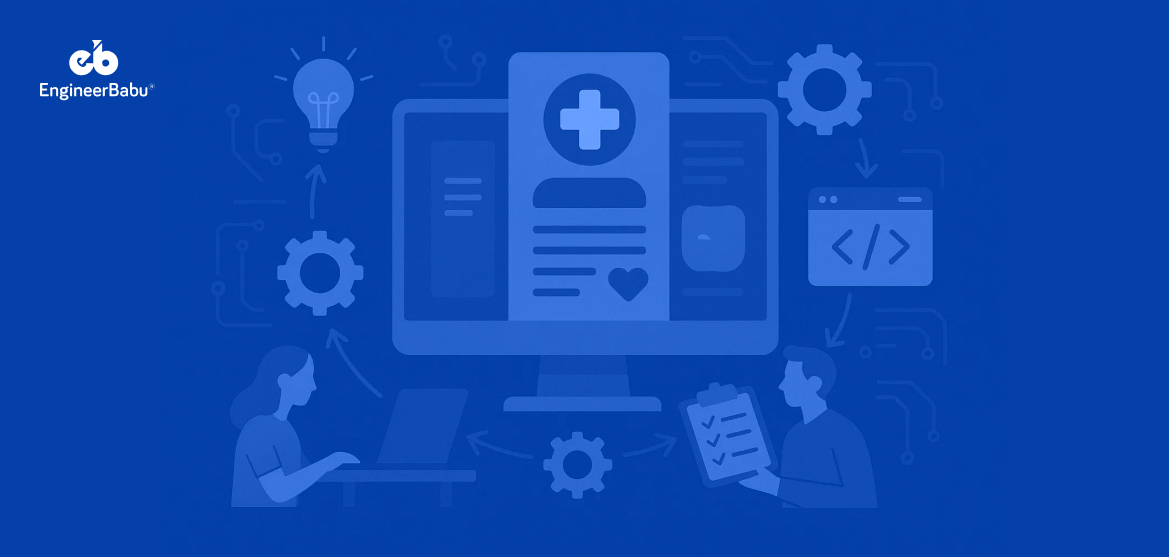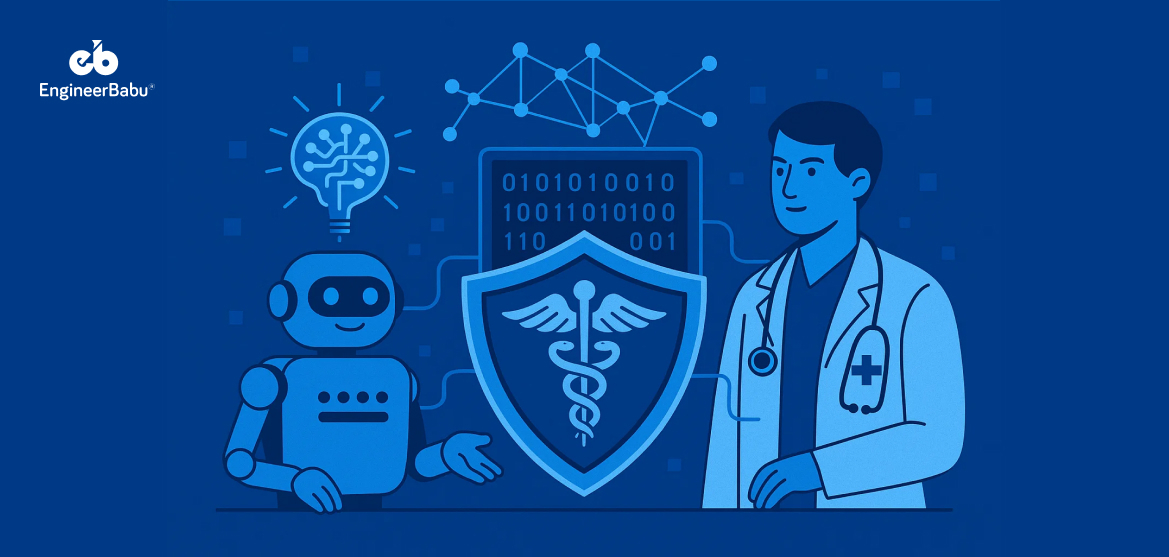In 2023 alone, U.S. hospitals generated over 2.3 zettabytes of health data—yet a shocking 80% of that data remained unstructured and underutilized. Why? Because most healthcare systems still struggle with legacy software, siloed tools, and fragmented patient records that fail to “talk” to each other.
This is where Electronic Medical Records (EMRs) come in—not just as a digital filing cabinet, but as a mission-critical system that connects clinical, operational, and administrative dots.
A well-built EMR doesn’t just store patient history—it drives clinical decisions, improves billing accuracy, prevents medical errors, and reduces physician burnout by automating routine workflows.
However, building a robust, compliant, and interoperable EMR system is far more complex than spinning up a database and creating user logins. It demands deep alignment with clinical workflows, rigorous adherence to privacy laws (like HIPAA and GDPR), and the ability to scale with evolving standards like FHIR and HL7.
This comprehensive guide unpacks exactly how to design and develop a modern EMR system from the ground up. Let’s dive in.
Steps to Build an EMR Software
1. Define the Scope and Objectives
Before you write a single line of code, you need absolute clarity on what your EMR system is expected to do, who it serves, and how success will be measured. This isn’t just a project kickoff formality—it’s the blueprint that influences every architectural and clinical decision down the line.
Identify Stakeholders and Their Needs
Every healthcare facility operates differently, and your EMR must reflect the reality on the ground. Start by mapping out all stakeholders:
- Physicians need rapid access to patient histories, clinical notes, lab results, and e-prescriptions. They prioritize speed and clinical accuracy.
- Nurses often require streamlined charting tools, medication schedules, and alerts for care tasks.
- Administrative staff need modules for patient intake, insurance verification, billing, and reporting.
- Patients (if there’s a patient portal involved) expect access to visit summaries, test results, and appointment scheduling.
Interview representatives from each group. Use shadowing sessions in clinics to observe existing workflows. Identify repetitive pain points and inefficiencies in legacy systems—they’ll inform what features matter most.
Define Functional and Non-Functional Requirements
Once stakeholders are mapped, you need to translate their needs into concrete requirements:
- Functional Requirements might include:
- Role-based access control
- SOAP (Subjective, Objective, Assessment, Plan) note templates
- Lab result ordering and review
- Drug interaction alerts
- Audit trails for compliance
- Non-Functional Requirements include:
- System availability (e.g., 99.9% uptime).
- Response times for data retrieval (e.g., < 2 seconds for patient record load).
- Scalability to handle X number of concurrent users.
- Compliance with regulations like HIPAA, GDPR, or NDHM depending on geography.
These details will shape your architecture, performance benchmarks, and user experience strategy.
Decide on the Type of EMR System
Not all EMRs are built equal. You must decide early whether your system will be:
- General-purpose: Broad EMRs for multi-specialty hospitals and general practices.
- Specialty-specific: Custom-built for fields like dermatology, psychiatry, or orthopedics, which have unique data input and workflow needs.
- On-premise vs. Cloud-based: Cloud EMRs are faster to deploy and scale, but may face regulatory hurdles in certain regions.
Your decision will affect everything from your UI design to your database schema and hosting model.
2. Conduct Market Research and Compliance Assessment
Audit the Competitive Landscape—But Focus on Their Failures
Don’t just skim brochures from Epic or Cerner. Instead, map each feature against actual clinician workflows and determine where market leaders fail. For example:
- Epic’s template-heavy note system is often criticized for being rigid in specialties like psychiatry or dermatology.
- Allscripts users report frequent downtime and UI lag, especially in high-volume outpatient settings.
To validate, use:
- KLAS Research to identify vendor-specific pain points by specialty and practice size.
- Reddit (r/medicine, r/healthIT) and physician forums for unfiltered, frontline opinions.
- Glassdoor reviews of support teams to evaluate post-sales service quality—an often overlooked differentiator.
Take these gaps and turn them into functional requirements. If Epic users complain about navigating multiple tabs, design a unified clinical dashboard. If clinicians hate typing, build a voice dictation module with ambient AI (e.g., Nuance or DeepScribe APIs).
Treat Compliance as an Engineering Constraint, Not a Legal Checkbox
HIPAA or GDPR compliance shouldn’t be a paragraph in your contract—it must shape your technical architecture. Examples:
- HIPAA requires activity logs. So, your system must track every access to PHI with timestamp, user ID, and action taken, stored in immutable logs (e.g., AWS CloudTrail + WORM storage).
- Under GDPR, users must be able to delete or export their data. So, plan for soft deletion, audit trails, and user-controlled data export from Day 1.
- If aiming for ONC Certification, you’ll need to support:
- Clinical decision support rules
- Patient portal with access to records within 48 hours
- Standard APIs (FHIR DSTU2 or R4)
Tactical Tip: Get a HIPAA compliance checklist into your sprint backlog—not your lawyer’s inbox.
Architect for Interoperability by Default
Don’t wait until “Phase 2” to integrate HL7 or FHIR. Your core database design must reflect standard healthcare ontologies from the outset.
- Use FHIR resource models (Patient, Observation, Encounter) to shape your DB schema. This makes your app “FHIR-ready” without needing post-hoc adapters.
- Leverage HAPI FHIR server (Java) or Aidbox (for PostgreSQL/FHIR mapping) if you’re building from scratch and want future-proof APIs.
- Avoid hardcoding diagnostic or lab fields. Instead, map them to:
- ICD-10 codes for diseases
- LOINC codes for labs
- SNOMED CT for clinical findings
This structure is what lets you build real-time lab interfaces, tap into Health Information Exchanges (HIEs), and support value-based care models.
Verify Data Residency and Cloud Constraints Per Region
Cloud infra isn’t just a devops decision—it directly affects legal clearance.
- India’s ABDM framework mandates storage in India-based data centers, preferably MeitY-approved cloud providers.
- Germany’s BSI and GDPR rules prohibit PHI from being stored or processed in non-EU regions.
- Canada (PIPEDA) allows cloud usage but only if access control and encryption are fully auditable.
3. Design the System Architecture
An EMR system must do more than “work.” It must perform reliably under clinical pressure, adapt to future healthcare standards, and protect sensitive data without slowing down care delivery. The architecture you choose will define your system’s scalability, maintainability, and compliance posture for years to come.
Modular Backend with Microservices: Why It’s Non-Negotiable
Instead of building a monolith, opt for a microservices-based architecture, where each core domain of the EMR operates as a separate service (e.g., PatientService, VisitService, MedicationService).
This separation allows your system to scale independently and fail gracefully—crucial when multiple teams are building features in parallel, or when a module like billing needs to be upgraded without affecting patient care.
Example Use Case: Imagine you need to implement an ePrescription module that integrates with national drug registries. By keeping this in a separate MedicationService, you can:
- Plug into external APIs (e.g., Surescripts in the US).
- Apply drug interaction checks via a third-party engine (like First Databank or Medispan).
- Scale this service independently during prescription rush hours (e.g., flu season).
This way, if your pharmacy API is down, doctors can still access clinical notes and lab results.
Key Tools: Docker + Kubernetes for container orchestration, service discovery via Consul or built-in K8s DNS, and communication via gRPC or REST depending on service needs.
Use Node.js with NestJS for Healthcare APIs
Node.js is event-driven and highly performant in I/O-bound systems—ideal for EMRs, where 80% of operations involve fetching or posting structured data (e.g., patient charts, lab results). However, raw Node.js lacks structure, which is where NestJS excels.
NestJS is a TypeScript-based framework that brings Angular-style modularity and built-in support for:
- Dependency injection (for cleaner, testable services).
- Guards and interceptors (for enforcing RBAC and logging access to sensitive endpoints).
- OpenAPI generation (auto-generates Swagger docs from decorators).
This ensures only authorized users with proper roles can access sensitive patient data, satisfying both security and auditability from the start.
Database Layer: Designing for Structure and Flexibility
You’ll be working with both structured and semi-structured data.
- Use PostgreSQL for patient records, appointments, and billing. It supports strong ACID compliance, and with extensions like pgAudit, you get built-in query logging for HIPAA audits.
- Use MongoDB or jsonb fields in Postgres to store free-text clinical notes, templates, or form-based data that vary between specialties.
This allows clinicians to input nuanced data while maintaining schema consistency in other parts of the system.
UI Design That Respects Clinical Flow
The average physician clicks 400–500 times per shift in most EMRs. Every extra click is a tax on patient care.
React.js is the best bet for a clinician-facing web frontend because of:
- Component reusability (important when building forms, timelines, and alerts).
- Real-time updates via hooks or WebSockets (e.g., when labs or notes update mid-session).
- Smooth keyboard navigation (critical for minimizing mouse usage during charting).
This supports rapid clinical review, replacing 5–6 clicks with a single view. Clinicians can filter by event type (e.g., “Show only Labs”) and hover to preview without loading full modules.
Building for Resilience and Security in the Cloud
Cloud-native doesn’t just mean “hosted on AWS.” It means infrastructure that’s self-healing, secure by design, and auditable.
Architecture Example:
- Use AWS VPC with private subnets for core services and public subnets for the web app.
- Encrypt data at rest with KMS-managed AES-256 keys, and in transit via TLS 1.2+.
- Implement RBAC + attribute-based access control via tools like Keycloak or Auth0.
- Deploy via Terraform, enabling version-controlled, reproducible environments.
Bonus Tip: Enable AWS Macie or Azure Purview to monitor and classify PHI across storage layers. This ensures you’re alerted when sensitive data lands where it shouldn’t
4. Plan Features and Functional Modules
Designing a capable EMR system isn’t just about ticking off a feature checklist—it’s about prioritizing functionality that reflects real clinical workflows, aligns with compliance demands, and can evolve over time. This step is where your product truly becomes a healthcare tool, not just a tech platform.
Prioritize Clinical Core Features First
Building a clinically viable EMR begins with features that directly support patient care. These modules should reflect actual medical workflows and be optimized for speed, safety, and accuracy.
- Patient Demographics and Registration
The registration module is the first point of interaction between a healthcare provider and the system. It must go beyond capturing basic identity information and include details like insurance data, national health identifiers, emergency contacts, and consent flags.
To minimize data entry errors, implement validation rules—such as enforcing correct date formats, restricting invalid inputs, and requiring essential fields before allowing a record to be saved. A duplicate detection mechanism is also essential to prevent fragmented patient histories.
- Medical History & Charting
Capturing a patient’s longitudinal health history is critical for ongoing care. This module should provide structured templates for inputting symptoms, known conditions, allergies, vital signs, and previous interventions.
To maintain consistency and support future analytics, every input should be mapped to standard clinical terminologies like ICD-10 for diagnoses and SNOMED CT for findings. Additionally, historical data should be easily navigable, ideally through a timeline view, so clinicians can quickly contextualize a patient’s current condition.
- Progress Notes & Clinical Documentation
Progress notes form the clinical narrative of each visit and must accommodate various documentation styles. The system should support SOAP notes for general practice, structured templates for specialists, and free-text fields when flexibility is needed.
Importantly, each note must be timestamped, user-attributed, and version-controlled to meet audit and legal standards. Built-in autosave, pre-filled templates, and the ability to clone previous notes can significantly reduce documentation time and cognitive load for clinicians.
- Orders & Results
A modern EMR should facilitate the end-to-end process of ordering diagnostics and tracking results. It must allow clinicians to electronically order labs, imaging studies, or referrals from within the patient chart, while maintaining a consistent format for data.
Results should be ingested in a structured form, not just as scanned documents, to enable automated trend analysis—such as monitoring hemoglobin levels over time or flagging abnormal creatinine increases. Timely alerts, status updates, and result acknowledgment tracking are key features that enhance clinical responsiveness.
- Prescriptions & Medications
This module should enable fast and accurate medication ordering, complete with dosage, route, frequency, and refill instructions. Built-in drug interaction checking, allergy alerts, and dosage calculators increase patient safety significantly.
Integration with a national formulary or drug database ensures up-to-date availability, while optional pharmacy integration can streamline electronic delivery.
The system should also support prescription renewal workflows and digital signatures where legally permitted, reducing paper dependency and turnaround time.
5. Develop MVP and Test Extensively
Once your system design and features are defined, the next step is execution—developing a functional MVP (Minimum Viable Product) and validating it through rigorous testing. In healthcare, a buggy or half-baked MVP is not just a poor experience—it can lead to clinical risk, compliance failures, and erosion of user trust. That’s why the MVP must be strategically scoped and thoroughly tested in real-world conditions.
Define What Truly Belongs in the MVP
Your MVP should include only those features that are absolutely essential for a clinician to complete a full patient encounter without relying on external tools. This usually includes patient registration, medical history input, clinical documentation, ordering labs, and writing prescriptions. Modules like analytics, telemedicine, or patient portals can be deprioritized unless they’re critical to your immediate use case.
Keep the scope focused—resist the urge to overload the MVP with secondary features. Instead, validate whether the core functionality solves real workflow issues for early users.
Use Agile Development with Clinical Feedback Loops
Build the MVP iteratively using agile sprints. Involve clinicians, nurses, and administrative staff in each sprint cycle. Their feedback should guide UI adjustments, workflow refinements, and terminology alignment. Clinical staff are rarely trained software testers, so design short feedback sessions around practical tasks they perform daily.
By integrating real clinical input into early builds, you avoid costly rework later and ensure your design aligns with actual user expectations, not just what the development team assumes they need.
Set Up a Real-World Pilot Deployment
Before a full-scale rollout, conduct a pilot in a controlled but realistic setting—such as one outpatient clinic or a single department within a hospital. This environment allows you to evaluate system performance under operational stress and identify usability issues that don’t appear in development or QA environments.
Monitor key metrics: average time to complete a patient note, prescription error rates, and clinician satisfaction scores. The pilot should also assess infrastructure readiness (e.g., load times on hospital networks, offline support if needed).
Test Beyond Functionality: Focus on Reliability and Safety
In healthcare, it’s not enough for features to work—they must work consistently, securely, and predictably. Testing should cover multiple layers:
- Unit and integration testing to ensure feature-level and system-wide stability.
- Role-based access testing to confirm users see and interact only with what they’re permitted to.
- Data validation and boundary testing to prevent input errors, data corruption, or inconsistencies.
- Performance testing under simulated peak loads to measure system responsiveness.
If your EMR will be deployed in a regulated region like the U.S. or EU, include compliance testing against HIPAA, GDPR, or ONC criteria as required.
Fix Issues Rapidly and Re-Test Continuously
Post-pilot, focus on rapid iteration. Prioritize feedback that directly impacts safety, usability, or clinical efficiency. Bug fixes and enhancements should be pushed quickly—but with regression testing in place to ensure existing workflows remain intact. Use version-controlled environments and automated test scripts to streamline this process.
6. Monitor, Maintain, and Improve
Deployment isn’t the end of EMR development—it’s the beginning of a long-term commitment to performance, compliance, security, and user satisfaction. Without active monitoring and continuous improvement, even a successful launch can devolve into user frustration, data risks, and outdated functionality. This step ensures your EMR system stays reliable, scalable, and aligned with evolving clinical needs.
Establish Continuous Monitoring from Day One
Set up real-time monitoring to track system performance, errors, and user behavior. Use tools like Prometheus, Grafana, or cloud-native monitoring (e.g., AWS CloudWatch, Azure Monitor) to watch server loads, API latency, and uptime. For frontend behavior, track page response times and error rates using tools like Sentry or LogRocket.
Monitoring also includes business-level metrics: login frequency, patient record access patterns, and time spent on documentation. These insights help identify friction points or underutilized features that may need refinement or re-training.
Create a Formal Support and Issue Resolution Workflow
Post-launch, end users will encounter bugs, request changes, and need assistance. Establish a centralized support desk and ticketing system—whether through an internal helpdesk or integrated support module. Assign SLAs (service level agreements) based on issue severity: for example, resolve critical patient record issues within 4 hours and general feature bugs within 48.
This support structure not only maintains operational continuity but also builds clinician trust in the system.
Schedule Regular Updates and Feature Enhancements
Technology, regulations, and clinical workflows all evolve. Plan for regular system updates—not just to patch security vulnerabilities, but to introduce new features, improve UX, or meet changing compliance requirements. These should be bundled into quarterly or bi-annual release cycles with minimal disruption to users.
Avoid adding features reactively or without consultation. Instead, maintain a product backlog prioritized by user feedback, regulatory needs, and strategic goals. Communicate upcoming changes well in advance to minimize resistance.
Conduct Periodic Security and Compliance Audits
Healthcare regulations are not static. To stay compliant with frameworks like HIPAA, GDPR, or ABDM, conduct periodic audits of data storage, access logs, breach detection protocols, and backup systems. Include third-party penetration testing annually, especially before adding major integrations or expanding into new geographies.
Audit trails should be automatically maintained and reviewed at regular intervals. Any anomalies—such as unauthorized access to patient records—should trigger alerts and be escalated for investigation.
Conclusion
Building an EMR system demands more than clean code and modern frameworks; it requires a deep understanding of clinical workflows, regulatory landscapes, patient safety concerns, and long-term system resilience.
By following a structured, step-by-step approach—from defining scope and designing a modular architecture to ensuring interoperability, compliance, and continuous improvement—you don’t just create a digital record system. You build a critical tool that supports doctors in delivering better care, reduces administrative friction, and empowers patients to take control of their health.
As healthcare continues to digitize and decentralize, EMRs will play an even more central role in shaping how care is delivered. The systems that succeed won’t be the ones with the most features—but the ones that integrate seamlessly into the lives of clinicians and patients alike.




